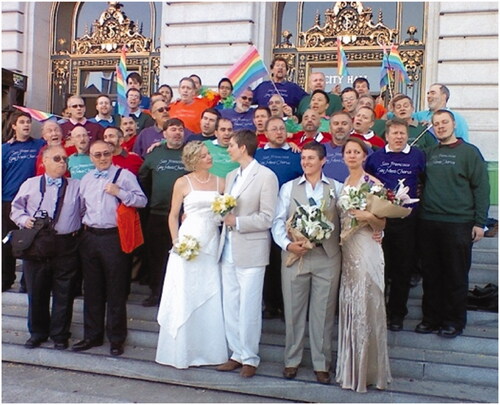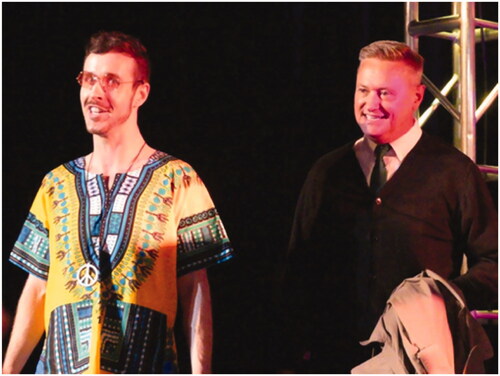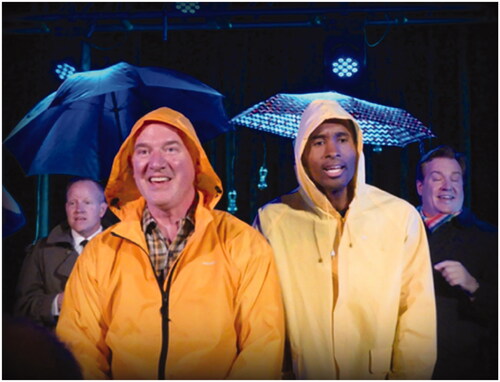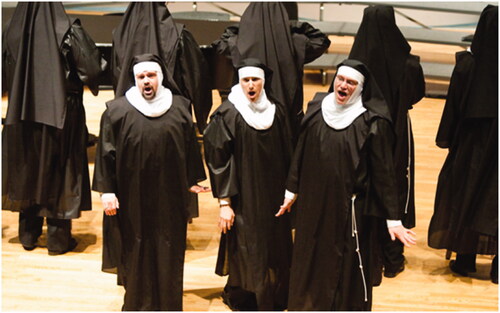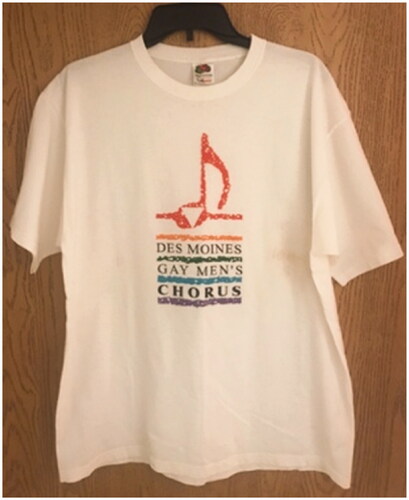Abstract
During the 1970s, people in the United States founded gay and lesbian choruses for political activism, coming out, and celebration. We examined the history of one of these choruses, the Des Moines Gay Men’s Chorus (DMGMC). We asked, how do their bodies in motion and styling-fashioning-dressing produce, distribute, and negotiate queer representations? How do they appear across space and time? How can these style-fashion-dress acts open multiple interpretations and dialectical subtleties? To answer these questions, we analyzed the original DMGMC slogan T-shirt, the digital archive of historical LGBT T-shirts, performance videos and imagery, song lyrics, news articles, and oral histories. The chorus members negotiated queer sensibilities, choral traditions, activism, and community building through their T-shirts and performance costumes in complex ways. They negotiated queer representations by creating temporary queer spaces during the AIDS crisis and highlighting how community and visibility have been significant in gay history. However, the chorus often prioritized an appropriate kind of gay man via dress, which they reinforced through racial-power dynamics, complex-gender associations related to tuxedos, and cabaret performance outfits that included nun’s habits. The chorus’ various collective styles esthetically represent how gay men’s choruses navigate entanglements of tradition, gayness, and music while reclaiming oppressive symbology.
During the 1970s, Americans in gay and lesbian communities founded choruses to create spaces for political activism, meet other gay and lesbian people, come out and embrace their sexual identity, and celebrate through song (Hilliard Citation2008). The choruses practiced in a variety of community-oriented locations such as schools, churches, and community centers. As these choruses grew, the Gay and Lesbian Association of Choruses (GALA) formed in 1981 to organize and lead this choral movement, and they hosted a quadrennial choral festival where associated choruses gathered to sing for one another in a spirit of harmony. In the twenty-first century, there are almost 200 GALA-member choruses throughout North America, South America, Europe, Africa, and Australia (Gay and Lesbian Association of Choruses Citation2021); these contemporary groups continue to embrace the political, social, and celebratory philosophies that were foundational to the earlier choruses (McNally Citation2018). Since being founded, the choruses’ performances have featured members in various collective styles demonstrating a collective community identity (Kenny Citation2019). For example, on June 17, 2008, a day after the same-sex marriage legislation passed in California, the San Francisco Gay Men’s Chorus sang on the steps of the capitol building behind newlywed couples, and each chorus member wore a collared shirt with a different solid-colored sweatshirt on top to create a rainbow effect ().
How then do these chorus members’ collective dress practices reflect the ideologies of their choruses in terms of queerness, politics, activism, and community? By using a case study approach (Gillham Citation2000), we examined the history of one of the GALA-member choruses, the Des Moines Gay Men’s Chorus (DMGMC), within the context of the larger queer chorus movement in the latter part of the twentieth century in the United States. We examined how the organization formed and changed and how these changes influenced the members’ collective performance styles and slogan T-shirts as they celebrated and mediated queer sensibilities, activism, politics, and community building while negotiating long-standing choral esthetic traditions.
Emergence of queer choruses in the United States
The ANNA Crusis Women’s Choir of Philadelphia, founded in 1975, is one of the earliest gay and lesbian choruses in the United States (ANNA Crusis Citation2020). Other choruses were established soon after. One notable example is New York City’s Gotham Male Chorus, which was established in 1977 and expanded beyond the traditional male vocal parts of tenor and bass to include all genders and soprano and alto parts; it later renamed itself the Stonewall Chorale. The San Francisco Gay Men’s Chorus (SFGMC), founded in 1978, was the first group to include the word “gay” in their name (Gay and Lesbian Association of Choruses Citation2021), and its first performance occurred during a candlelight vigil held after the murders of Harvey Milk and George Moscone (Hilliard Citation2002). After the development of the SFGMC, many gay and bisexual men’s choruses began to emerge (Portland Gay Men’s Chorus Citation2017) such as the Portland Gay Men’s Chorus, Rochester Gay Men’s Chorus, and Turtle Creek Chorale (Gay and Lesbian Association of Choruses Citation2021). Many of these organizations advocated gay solidarity, safety, and acceptance in wider society (Turtle Creek Chorale Citation2019). Gay women’s groups were also formed, and they frequently embedded explicit feminist principles into their organizations and practices (ANNA Crusis Citation2020).
In the 1980s, AIDS-related deaths devastated choruses across the country, and memberships plummeted. For example, in Oregon, the Portland Gay Men’s Chorus lost two-thirds of its members because of the AIDS epidemic (Portland Gay Men’s Chorus Citation2017). In California, the San Francisco Gay Men’s Chorus also lost many members to AIDS and memorialized these deceased members on their website. Those who passed away because of AIDS were considered members of a missing “Fifth Section,” a name that refers to the traditional four-part division of voices of choral music (San Francisco Gay Men’s Chorus Citationn.d.). Following these tragic deaths, chorus members often gathered to sing in memory of and to mourn the loss of individuals and community cornerstones as well as to maintain gay community social connections during the collective tragedy (Attinello Citation1994; P. Hengesteg, personal communication, October 20, 2020).
Many chorus groups promoted social justice and equity core values and acted on these principles by regularly engaging with their surrounding communities. For example, some chorus members, including ones participating in the Turtle Creek Chorale, developed various curricula and teaching tools to be used in schools, ranging from technical choral materials to content about LGBT identities and history (Turtle Creek Chorale Citation2019). In addition, regularly held gay ensemble festivals emerged that were open to the public, and choruses frequently hosted benefits and performances alongside the top names in Broadway and the film and music industries (New York City Gay Men’s Chorus Citation2020; San Francisco Gay Men’s Chorus Citationn.d.). Choruses frequently attended or participated in Pride festivals and parades and often expressed solidarity with other activists such as those in the Black Lives Matter movement (ANNA Crusis Citation2020). Chorus groups also carefully considered which communities they would perform in while intentionally choosing venues based on potential community impact; they often prioritized these considerations over the security and the emotional or physical safety of their members. For example, the San Francisco Gay Men’s Chorus completed a tour in 2010 after California passed Proposition 8, a constitutional amendment that defined marriage as the union between a man and a woman; they chose venues in areas that mostly voted in favor of the measure, a politically motivated decision to bring an overt gay visibility to these areas (Nevius Citation2012).
The DMGMC is one of the many queer choruses that has emerged since the 1970s. Through analysis of the DMGMC as a form of embodied queer place-making, we aim to highlight how the identities of cisgender gay men are enacted and negotiated through a spatiotemporal lens (Massey Citation2005), adding more depth to considerations of the intersections of Midwestern queer and fashion history. We specifically use the phrase cisgender gay men here because the chorus is largely composed of individuals occupying these identities. Moreover, the Midwest is often thought of as a geographic space where queerness is absent (Brekhus Citation2003); therefore, by drawing upon Cresswell’s (Citation2004) concept of place, or the “space invested with meaning in the context of power” (p. 12), we examine how the DMGMC created an embodied collective queerness at different times and in different spaces throughout the Midwest. We seek to examine relationships created among physical locations, embodied practices, and other social contexts with consideration of time–space (Massey Citation2005). Therefore, we ask, how do the DMGMC bodies in motion produce, distribute, and negotiate queer representations? How does their styling-fashioning-dressing (Tulloch Citation2010) intersect with these representations? How do they appear across space and time? How can these temporal style-fashion-dress acts open up multiple interpretations and dialectical subtleties?
Methods
To answer these questions, we used a historical method approach and considered primary sources to “provide a firsthand account” (Fitzpatrick Citation2001, 411). To enhance the trustworthiness of our work, we considered triangulation or “the process of corroborating evidence from different … types of data … in descriptions and themes in qualitative research” (Creswell and Guetterman Citation2019, 261). Fitzpatrick (Citation2001) also explained that “two independent primary sources that corroborate one another establish fact, as does one primary source corroborated by an independent secondary source that contains no substantial contrary evidence” (412). However, we do not suggest that we are proposing facts, we offer multiple potential interpretations through our analysis (Kaiser and Green Citationin press). We drew upon numerous primary sources including the original DMGMC slogan T-shirt, the digital archive of historical LGBT T-shirts on Wearing Gay History’s website, online content featuring video and imagery of DMGMC performances, song lyrics, and news articles.
We obtained access to the original slogan T-shirt worn by the DMGMC at Iowa State University’s Textiles and Clothing Museum. For our initial analysis of the shirt, we followed an abbreviated version of Prown’s (Citation1982) method by first conducting a rich description of the T-shirt focusing specifically on “content,” including the logo (8). Then, we employed speculation or the “free association of ideas” (10). We also engaged in a program of research for which we shifted to external evidence for potential interpretations, including peer-reviewed literature and the Wearing Gay History digital archive. We drew inferences by moving among the physical T-shirt, our description and speculation notes, peer-reviewed literature, and the digital archive. We also followed a similar method for analyzing the T-shirt logos available on the Wearing Gay History digital archive as we incorporated these objects into the narrative.
We also used online sources such as DMGMC’s website and its social media, including their pages on Facebook (established February 6, 2010; about 15 posts a month), Instagram (established on October 22, 2017; 139 posts), and YouTube (established June 4, 2013; 18 videos). After analyzing their online sources, we identified the need to analyze song lyrics; therefore, when copyright permitted, we obtained the lyrics. We also searched databases (Access World News, Gale OneFile: News, Des Moines Register, Newspaper Source Plus, and Alt-Press Watch) for new articles using search terms such as “Des Moines Gay Men’s Chorus,” “DMGMC,” and “Des Moines Men’s Chorus,” which resulted in identifying six articles published between 2004 and 2018.
We also drew upon firsthand experiences through oral histories (Ritchie Citation2003) that included the accounts of three current and long-term members of DMGMC: Paul Hengesteg, who has been a member since around 2011; Eric Olmscheid, who has been a member since 2009; and John Schmaker, who founded the Des Moines Men’s Chorus in 1984 and currently serves as its treasurer. The oral history narratives are about two hours long and were recorded via video chat. We asked thirty-six questions about the history and structure of the organization (e.g., How, when, and why did it start? How often do you get together? What kinds of songs do you sing?); their experiences in the organization (e.g., What does it mean to you to be a part of this organization? Why did you join? What experiences have influenced you to stay with the organization?); the collective styles worn during performances (e.g., What garments or styles do you wear collectively? Why do you wear these styles or garments?); and the original slogan T-shirt of the organization (e.g., Who designed the shirt? What meanings does the design hold? Are there similar shirts the group wears? If so, what is the history and meaning of those shirts?). At the end of the interviews, we asked if there was anything else that would be important to know about the history of the DMGMC and the different styles worn by the group to inquire about aspects of the group that were not covered in the preformulated questions. The interviews were recorded and transcribed verbatim for analysis. After transcription and during the process of writing the manuscript, we asked the interviewees for follow-up information as new questions emerged.
We used a cyclical thematic analysis to examine the varying sources following the open, axial, and selective coding processes (Creswell and Guetterman Citation2019). During open coding, we wrote down all possible themes and looked for similarities and differences. Then, during axial coding, we began grouping similar themes and noted when we found themes across different source types. Then, during selective coding, we identified larger themes to help organize the data. In addition to considering themes, we also noted changes in different spaces and changes over time within the varying cultural contexts to make sense of our interpretations through a space–time lens. We moved back and forth among the data, our results, and the peer-reviewed literature. We presented our findings, whenever possible, in chronological order via a historical narrative and highlighted themes in relation to time and space using rich, thick descriptions.
Des Moines Gay Men’s Chorus: Queer place-making and embodied practices
The early years: 1984 to 1991
In 1984, Schmaker founded the Des Moines Men’s Chorus (DMMC) in his basement; the chorus was much smaller than the current group, consisting of about eight to ten members. He saw that the chorus movement was thriving in other cities and said, “Why not have our own?” During the 1980s, the DMMC performed at an art center, churches, and a state historical building in Des Moines (J. Schmaker, personal communication, June 1, 2021). The members chose the original chorus’ name in the 1980s without including “gay” because of the significant homophobia in Iowa at that time and the potential for backlash against its members (Spoerre Citation2019). Schmaker explained,
Back in the 80s there were just too many guys who were afraid to use the word “gay” in our title. Some of them would’ve lost their jobs back then, a couple of schoolteachers. I tried [to include the word “gay”], but we had to settle on Des Moines Men’s Chorus in that first iteration. And then after that hiatus, we re-formed; we called it the Des Moines Gay Men’s Chorus, and everybody was a lot happier. We just weren’t ready for it in the middle of the 80s. (personal communication, June 1, 2021)
The act of turning Schmaker’s basement, which is partially hidden beneath the ground, into the gathering place, instead of using a public place, also cooresponds with the fear of overtly using “gay” in the group’s name while demonstrating how the members embodied and manifested queer practices in these places by creating meaning through a time–space lens (Massey Citation2005).
Schmaker’s comments highlight the significant need people had in the 1980s for temporary queer space-making to experience a sense of community and safety; the basement where the chorus members gathered was one such temporary space that allowed for these experiences. Hengesteg similarly related,
The history of the choral movement has come from this notion of queer people not having a voice, not having a place in society where people will say, “Listen to me, dammit.” When the AIDS crisis happened, LGBT people, particularly men, needed a way to process that grief in a productive way, and music helped the community do that. (personal communication, October 20, 2020)
As the chorus grew, DMMC members participated in their first GALA festival in Seattle, Washington, in 1989, where the T-shirt in was distributed. Schmaker explained that their participation in the festival “put Iowa on a map in gay consciousness because we did a concert, and we were every bit as good as the New York City Gay Men’s Chorus” (personal communication, June 1, 2021). His comment highlights the bicoastal assumptions subtending beliefs “that mundane, ordinary suburban gay men or Midwestern lesbians are somehow less authentically gay than visible urban coastal gays and lesbians” (Brekhus Citation2003, 3). Through this performance, the chorus members challenged these assumptions about Midwestern queer life.
Figure 2 1989 GALA T-shirt. Courtesy of WearingGayHistory.com and the Jean-Nickolaus Tretter Collection.
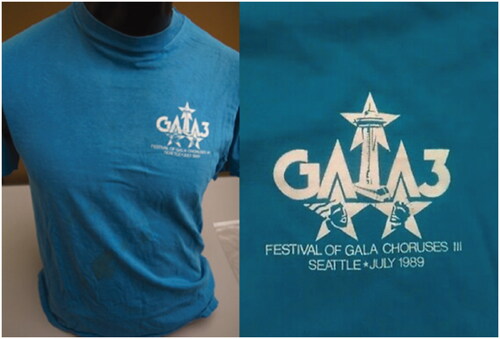
The T-shirt logo from the 1989 event reads, “GALA 3 Festival of Gala Choruses III Seattle July 1989.” Those in the know may read and interpret this T-shirt as a queer representation, but the signs are subtle, potentially reflecting when and where the shirt was worn. Although Seattle LGBTQ activists in the late 1980s had made some progress toward equity, such as extending health benefits to domestic partners and establishing a mental health organization for the LGBTQ community (Seattle LGBTQ Community Development Citationn.d.), other choruses in different parts of the country were experiencing more hostile, toxic, and dangerous environments.
Because of these complicated environments, the T-shirt designer presented subtle queer signs such as the two masculine-appearing faces that are looking at one another and situated within the two stars in the center of the 1989 GALA logo. The positioning and proximity of the two images reflects a homoerotic undertone that hints at the romantic act of stargazing. Additionally, the shape of the letter “A” produce triangles that are reminiscent of the activist symbol reclaimed by the queer community following their forced use of triangle patches during the Holocaust (Elman Citation1996). One of the more obvious signs of concealed queerness is use of the acronym GALA. The design choice of using the acronym allowed chorus members to embody an overt but collective queerness in temporary queer choral spaces, travel to other locations such as Iowa with the same T-shirt, and covertly move through places while creating meaning for those who could recognize in this embodied queer discourse.
The group had momentum in its early years, but unfortunately, in 1991, the DMMC lost its director and could not find another, resulting in a ten-year hiatus. During this time, some of the early members kept in contact but only outside of the DMMC queer space–place context.
Reinvented: 2001 to the present
In 2001, the group chose a new leader, Dr. Buikema, to direct and conduct. Doyle Monsma, a member since 2001 stated, “It started with a group email. Word started getting around, and there were probably fifty of us in that original group” (Delaney Citation2017, para. 5). During this reinvention, the group transitioned to becoming the DMGMC. By including “gay” in the new name, the ensemble established an overt queer identity, as opposed to the original title’s tacit expression of queerness (P. Hengesteg, personal communication, October 20, 2020). Then, in 2005, Dr. Rebecca Gruber, an LGBT ally (The Register’s Editorial Staff Citation2014), succeeded Dr. Buikema and led the group until 2020; at present, the group is searching for a new director (J. Schmaker, personal communication, June 1, 2021).
Membership
Members do not need to audition or be able to read music, and currently, they can be any gender or sexuality. The only membership requirement is that the individual must be able to sing in the tenor or bass ranges (P. Hengesteg, personal communication, October 20, 2020). Within the body of the DMGMC is a smaller ensemble known as HarMENy, which is also referred to as “Men in Harmony”; entry into this ensemble is contingent upon an audition, and the size of the group is limited to ten-to-sixteen members. Many members have reported they feel a sense of belonging in DMGMC spaces; for example, Joe Freund, a member since 2001, who has performed in every DMGMC concert except their first, said, “I didn’t come out until I was in my forties, and this group has been a natural fit for me. I feel I can really be myself here” (Delaney Citation2017, para. 5).
The members are mostly white-appearing cisgender gay men. In the past, DMGMC has had straight cis men and nonbinary members, but the group lives “in the tradition of the Gay Men’s Chorus” (E. Olmscheid, personal communication, April 29, 2021). This also reflects the group’s ongoing struggle with the gendered language and binary sexual identities suggested by their title. Olmscheid said,
Gender is not so binary as the mainstream believed as well as how people are identifying in saying, “I’m not comfortable saying I’m a gay man”; but I’m saying, “I want to sing, right?” We’re wrestling with those things now, and how do we be an inclusive and diverse organization but still honor our roots [and] traditions? (personal communication, April 29, 2021)
Throughout its history, the group has also grappled with racial inequity. In their interviews, Hengesteg, Olmscheid, and Schmaker all noted the obvious lack of racial diversity. Hengesteg explained, “So one of the things that we’re challenged with right now is that we’re a very white group. I can think of immediately three singers of color that I’ve seen in the group in my now close to six years” (personal communication, October 20, 2020). Schmaker further related,
There have also been a couple of Black members in the past. Members are all ages, and they have included Drake students and retired members. Members also hold a variety of occupations, such as servers, doctors, college administrators, and band instructors and have a variety of socioeconomic statuses but are mostly middle-class. (personal communication, April 29, 2021)
This prominence of whiteness is reflected in much of the T-shirt imagery for chorus groups across the United States and suggests the notion that “racism is ordinary” (Delgado and Stefancic Citation2017); therefore, while the group is engaging in queer-space making, queer people of color may not view this space like these white-appearing gay men do, a sentiment that permeates many queer spaces (Barry and Drak Citation2019).
Although the DMGMC experienced a lack of racial diversity, a white-appearing man wore a dashiki in the context of what appeared to be a 1960s hippie costume () during a performance. Creative styling does not happen in a vacuum, and there are networks of power at play when a white-appearing man adopts a garment that symbolizes freedom and liberation for Black people in the United States (Ford Citation2019). It is possible this and similar social media images contributed to people of color avoiding the group; when considering this costume and their lack of racial diversity, did the members of the chorus think through the concept of cultural hybridity or the source community for the dashiki, the significance of it design, and how similar this dashiki was to ones worn by, for example, the revolutionaries in the Black Panther Party? (Scafidi Citation2005).
Choral traditions: Tuxedos, bow ties, and button-ups
During their three ongoing public concerts a year, each consisting of two performances, members perform music that reflects the organization’s values and goals. Of their three concerts, one is a formal solstice concert held in December, and another is a formal spring concert held in March. Olmscheid described what the chorus considers when choosing music for their main shows:
Our vision statement is to sing music that matters, that’s kind of our top line. It’s figuring out what matters in the moment. Where are we socially? Where are we politically? Where are we personally? And then connecting it to each of those three concerts. There’s usually always music that is more serious in nature, that is from the LGBTQ perspective. And there’s usually music that’s more just fun, even if looking at the holiday [formal solstice] concert, there’s some holiday favorites. People want some comfort food, they want to hear some things that they want to hear, but we also want to challenge them and make sure that we’re pushing our mission forward. It is a little bit of both. (personal communication, April 29, 2021)
Some of these social justice-focused songs included “Marry Us” about legalizing gay marriage and “I Am Harvey Milk” about the legacy of Harvey Milk (E. Olmscheid, personal communication, April 29, 2021). One of the campier numbers the DMGMC has performed is “Somewhere Over the Rainbow” because, as Schmaker explained, “you just can’t go wrong singing ‘Over the Rainbow’ with a gay chorus. Everybody ends up weepy” (personal communication, June 1, 2021).
During the solstice and spring concerts, attire is relatively uniform and follows mainstream choral tradition. Hengesteg described the dress code as follows:
For the solstice and spring concerts, members are expected to wear a tuxedo consisting of, of course, black on black, a white shirt with the lay-down collar, a bow tie or a four-in-hand tie is acceptable. We prefer a vest, also in black. Cummerbunds are really not that common anymore but could be done. Tux shoes, so like the shiny tux shoes. Black, at least crew-length, socks. (personal communication, October 20, 2020)
For these concerts, members almost exclusively wore their tuxedos for the entire performance (P. Hengesteg, personal communication, October 20, 2020). Although tuxedos can be expensive, members tried to lessen the financial burden for members who could not afford one:
So every man has a tuxedo [and] is expected to get one, and we do what we can to make that not a burden for people, right? Like, “Oh, Steve has an extra tuxedo he doesn’t wear anymore. Maybe it’ll fit you.” All of those things … This place has a big sale on tuxedos this week. So like, ‘Go get a tuxedo.’ But everybody’s expected to have a tuxedo. (P. Hengesteg, personal communication, October 20, 2020)
Well-fitted tuxedos are frequently worn by choruses during performances to demonstrate uniformity and formality (Blaisdell Citation2018). The DMGMC demonstrates a commitment to both traditional choral formality and community by considering economic inclusivity. Retiring members also frequently donated their tuxedos to the chorus, which would distribute them to new members who could not or did not wish to purchase a tuxedo. This sharing of tuxedos depicts the significance of social relationships within gay men’s choruses, something that each of the interviewees and Attinello (Citation1994) and Hilliard (Citation2008) have written about extensively. Many members reported the choruses have improved their social lives and well-being. Olmscheid expressed the importance of friendship in the DMGMC by saying that
one of the things I’m particularly proud of in my little chorus, is that it’s caused the development of some really nice social networks among the singers. There’s some really great friendships [that] have come together … So it pleases me to see the effect from the chorus, that we’ve become bigger than just a group that gets together to sing. (personal communication, April 29, 2021)
Additionally, community formation has been important for gay people throughout American history, as seen in bathhouse, drag, and club cultures (Newton Citation1972).
Although DMGMC members were expected to wear tuxedos, they could alter the garments to fit their personal style. Within the system of style-fashion-dress, style denotes “agency—in the construction of self through the assemblage of garments, accessories, and beauty regimes that may, or may not, be ‘in fashion’ at the time of use” (Tulloch Citation2010, 276). Schmaker explained how chorus members styled their costumes:
Being the gay men that we are, you could accessorize with brooches and rhinestone and whatever you want to do. We always managed to keep it tasteful, but everybody could accessorize with a little bit of glitter here and there to augment their tuxedos. (personal communication, June 1, 2021)
Schmaker connects gay men’s group membership to their expressions of personal style because members navigate the tension between traditional formal choral appearance and styles stereotypically associated with white cisgender gay men’s identities. These styles are expressions of “fabulous masculinities,” unique negotiations among masculinities and the body via dress (Barry Citation2019, 276). The DMGMC members augment their tuxedos to fit their personal styles as informed by their conception of their masculinity. Tuxedos are not only related to choral formality but also have complex gender associations: they are normative formal men’s attire and often associated with masculine icons such as James Bond, but they are also seen as opulent and immaterial, attributes that are typically identified as feminine (Barry Citation2018). Additionally, potential members who do not identify as cis men may be uncomfortable with this dress code (Blaisdell Citation2018). Schmaker also generalized about gay men’s style based on the primarily white cis composition of the chorus. Crits stipulate that Americans typically consider whiteness as the default (Delgado and Stefancic Citation2017), a perception that Schmaker perpetuates by conflating gay men’s style and the appearance of the predominantly white chorus. Members maintained a uniform appearance while expressing themselves through personal style, further exemplifying their negotiation of group formality and individuality championed by social liberalism.
Cabaret: Nuns, kink, and camp expressions
The chorus’ cabaret-style concerts began in 2009 with their performance of “How Sweet It Is,” and they now occur every June as a celebration of Pride Month (Iowa Living Magazine 2015). In contrast to the other two main concerts, Hengesteg described the cabaret show’s tone as “an opportunity for the chorus to ‘let their hair down’” and “to do something a little bit naughtier, a little bit riskier, a little bit off the choral path that is not your Bach or your Andrew Lippa” (personal communication, October 20, 2020). The cabaret performances typically involved costume changes between almost every number, and outfits often corresponded with the content of a particular song; for example, Schmaker explained, “If it was a song about cowboys, we’d be cowboys and dress like it, things like that” () (personal communication, June 1, 2021). Similarly, during a spring concert, members wore rain ponchos for a rendition of “It’s Raining Men” () (P. Hengesteg, personal communication, October 20, 2020). For some numbers, instead of wearing a special costume, singers donned khakis and “solidly colored [polo] shirts, but six or seven different colors, everybody would wear. And so you’d see a panoply of colors across the stage” (J. Schmaker, personal communication, June 1, 2021).
Figure 4 DMGMC member at a concert wearing a cowboy hat and performing shirtless. Courtesy of the DMGMC.
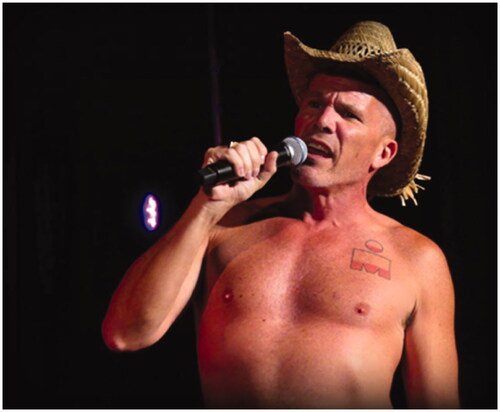
Cabaret performance outfits typically diverged from formal choral attire to reflect a gay white male esthetic. Schmaker added, “we always try to make those more fun than anything else, so a lot of satire, and funny songs, and outrageous costumes, and things gay men do” (personal communication, June 1, 2021). Schmaker used appearance to draw connections between the identity and expression of white cis gay men. Although Schmaker does not specifically identify whiteness and cisness because most of the other members identify as white and cis, the members of the chorus often reflect a white cis gay male sensibility.
The DMGMC has also reflected a cis gay male sensibility by wearing nun’s habits during performances (). Gay men have a long history of dressing as nuns for activism. For example, activists founded the Sisters of Perpetual Indulgence, a drag group famous for wearing nun’s habits, in 1979 (Sisters of Perpetual Indulgence Citationn.d.). The Church Ladies of Choice, which stemmed from ACT UP and used less abrasive tactics than the Sisters (Shepard Citation2010), also wore nun’s habits and Sunday best when counter-protesting antichoice rallies. The Church Ladies of Choice ridiculed the nun as an icon of moral predilection through drag, thus queering morality. They also used song, though less formally and harmoniously than gay men’s choruses, to communicate activist sentiments. Although abortion rights did not personally affect most Church Ladies of Choice, they protested in solidarity because religious groups have also unfairly targeted and enacted violence against gay people (Cohen-Cruz Citation2002).
Consequently, many gay people, including gay Midwesterners, have complex relationships with religion. The Pew Research Center (Citation2015) finds that 73% of Midwesterners identify as Christian, and 63% of Midwesterners are certain there is a God. Hengesteg references the tension between right-wing expressions of religion and gay identity for some members:
There might be a piece that we pull from more religious notions, but we also are careful to understand that for the members, some of us have had rather traumatic relationships with Christianity or our faith. And that’s a real … that’s a spot that then all of a sudden makes the organization not so safe and not so comfortable. So if we’re going to sing a more religious piece, it’s going to be about the feeling of peace, of love, of understanding our place in the world, understanding the beauty of the world, that sort of thing. (personal communication, October 20, 2020)
To show greater support for the LGBT community, some congregations have invited the DMGMC to sing at their Sunday services. Hengesteg feels these churches are “doing what they can to say, ‘Hey, we’re welcoming. And we want our LGBT Christian followers to feel welcome with us if that’s what they want’” (P. Hengesteg, personal communication, October 20, 2020). These congregations reject right-wing expressions of religion by asserting it is possible (and acceptable) to be both gay and Christian.
Community activism: slogan t-shirts and overt activist fashions
In addition to the three main concerts they perform each year, the chorus also performs at nonrecurring engagements such as funerals, weddings, festivals, and other events, which are not limited to the Des Moines metro area. Many of these public engagements emphasize activism, and some specifically focus on queerness such as at Pride events for which members wear overtly activist fashions. However, because the organization is a 501(c)3 nonprofit, members do not consider it an activist group. According to the oral histories, members formally considered it more inclined toward “social commentary” (E. Olmscheid, personal communication, April 29, 2021) and “visibility” (J. Schmaker, personal communication, June 1, 2021). However, their presence is political, especially in many areas of the Midwest where people may not be accepting of queer people. Because gay men have historically been systemically oppressed, celebrating their history through song is subversive. For example, one of the songs the chorus sings, “Child of God” by Mark A. Miller, can be powerful for people grappling with tensions between religion and queerness, particularly when some churches in Iowa are pushing for anti-LGBTQ measures such as banning queer books in public libraries (Hayes Citation2018). Some of the lyrics read, “No matter what the church says,/Decisions, pronouncements on you,/You are a child, you are a child of God.” Most Midwesterners identify as Christian (Pew Research Center Citation2015), so the inclusion of songs about Christianity in the DMGMC repertoire may appeal to heterosexual Christians. Although the DMGMC’s displays of pride are subversive, they typically manifest in socially acceptable ways, such as by singing songs about Christianity. Hengesteg explained,
We want to make sure that we are present and a picture of LGBT people who are happy and successful in life going about their thing, proud of who they are, creative, have friends, right? We want to show the world that we’re not whatever awful image you may have in your mind about a group of gay men. (personal communication, October 20, 2020)
The group has sought approval from heterosexuals by attempting to distance themselves from negative stereotypes. The chorus comprises primarily white cis men, who are typically seen as more proximal to social ideals than queer trans people of color (Puar Citation2017), making them more likely to receive approval in society.
Although the group is not overtly political, they emphasize the importance of representation and visibility to promote the well-being of the community of gay men. Eric related that
For some it’s an affirmation of like, “Great, I’m so glad I’m represented. I see myself amongst that group of individuals.” And for others, it’s the first time they see themselves represented. I can’t help but think when we’re in small communities in Iowa doing concerts, there might be a questioning youth … seeing for the first time gay men being positively portrayed in their life. That’s a big deal. (personal communication, April 29, 2021)
This theme is reflected in their original slogan T-shirt that was designed in 2001 and worn by members to various political events. It has a screen-printed logo on the center front, which reflects some of the shifting meanings and signifiers in queer communities. The logo comprises five horizontal lines that resemble a music staff (); each line is a different color including (from bottom to top): purple, blue, green, orange, and red. The traditional six-color pride flag is abbreviated, and the resulting five bars align with the five-bar music staff of Western musical notation. The colored printing in the logo has rough lines and patches of negative space; these colored portions of the logo reflect contemporary tastes that are also evident in many other logos and media of the 1990s and early aughts (Vit and Gomez Palacio Citation2014) that can be interpreted as reflecting the trials that many gay people faced. Chief among these struggles has been outright persecution, suggested by the inverted triangle in the center of the note—a reminder of the badges forced upon homosexual men in Nazi camps (Elman Citation1996). Starting in the second space between the lines and moving down to the subsequent spaces, three lines of text read “Des Moines,” “Gay Men’s,” and “Chorus” in a serif font; the word “Chorus” is bolded. Standing in sharp contrast to the youthful, zeitgeist-infused energy of the colored portions of the logo, the black text is rendered in an all-caps serif font. This traditional, formal style reflects the often conservative choral world (Blaisdell Citation2018) and popular views of choral pieces; the juxtaposition points out that the simultaneous signifiers of the shirt—gayness, pride, tradition, music, and the reclamation of oppression—are not mutually exclusive.
The T-shirt in from the Maine Gay Men’s Chorus reflects similar subtleties, in that the “M” letters are composed of triangle shapes. Additionally, the white-appearing human figure is naked but wears a bowtie reflecting the dialectic entanglement of formal choruses, homoerotic desires, and oppressive symbology. The use of a white-appearing individual accentuates a homonationalism that “operates a regulatory script not only of normative gayness, queerness, or homosexuality, but also of racial and national norms that reinforce these sexual subjects” (Puar Citation2017, 2) The T-shirt in is also from the Maine Gay Men’s Chorus from 1997 and again features homonational stereotypes of white gay men: muscular, fit, strong—literally busting out of the shirt. The pink triangles are more pronounced, and the man is flexing his muscles—pushing the triangles away symbolizes a rejection of oppression, but it also embraces homonationalism.
Figure 8 Maine Gay Men’s Chorus T-shirt. Date unknown. Courtesy of Wearing Gay History and the University of Southern Maine Special Collections.
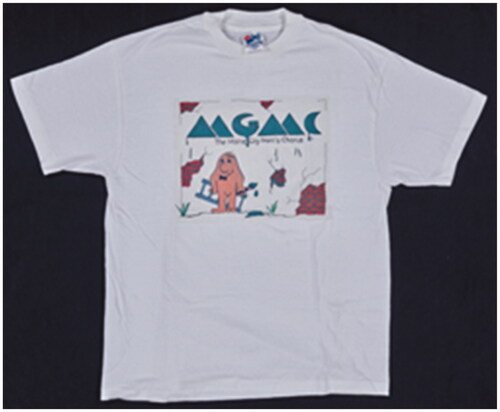
Figure 9 A 1997 Maine Gay Men’s Chorus T-shirt. Courtesy of Wearing Gay History and the University of Southern Maine Special Collections.
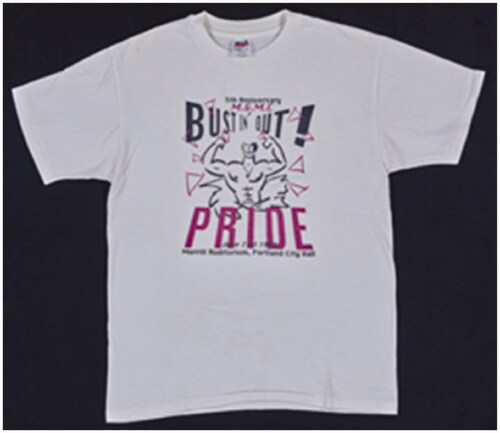
The DMGMC also had a shirt with the phrase “real men sing” printed on it. However, Olmscheid reflected that the shirts highlighted issues of homonationalism (Puar Citation2017) by prioritizing an appropriate kind of gay man for the chorus:
They were cute. They were humorous. Right. They had this like fun, old microphone on it. Those, I felt like—this is stylish and fun and cool. For obvious reasons. But it’s not really great. It’s problematic right now. So I’m hopeful that we’ll come up with something like that again. That’s more kind of contemporary, funny, that we can use but because our shirts also double as a performance attire; it is also great just to have something simple and clean, but it’s definitely a sense of pride. (personal communication, April 29, 2021).
He continued to relate how chorus members are considering what the chorus and its membership could look like in the future:
There’s a whole lot of other issues; there’s a whole lot of other challenges for the LGBTQ community. So now we’re shifting and thinking about, what does that mean? Where is our advocacy for trans voices? Where is our advocacy for nonbinary? Where is our advocacy for other people who are not perhaps living with the same freedoms as cisgendered gay men?
These sentiments are reflected in chorus’ recent participation in the 2019 Des Moines Pride Fest during which members wore matching polos and marched with pride flags that represented varying identities ().
Conclusion
Schmaker’s founding of the DMGMC precipitated the creation of a vibrant gay men’s community space in the Midwest. The group evolved to address the changing social and political landscape of the gay male community in the Midwest. They negotiated queer sensibilities, the choral tradition, activism, politics, and community building through their T-shirts and performance costumes in complex ways. The DMGMC produced, distributed, and consumed queer representations in its creation of a temporary queer space during the AIDS crisis, representing how community formation has been significant in the history of gay America, addressing the importance of representation and visibility for gay men, and thinking about what this could mean for the chorus and its membership in the future. However, the chorus often prioritized a so-called appropriate kind of gay man through dress, which they reinforced through racial power dynamics, the complex gender associations of tuxedos, and cabaret performance outfits that included nun’s habits. The DMGMC members also addressed these representations by negotiating formal choral attire, white cisgender gay men’s styles, group formality, and individuality. The DMGMC addressed particulars of space and time when designing outfits to correspond to a particular song or when performing at public activist engagements. Although Schmaker formed the chorus in the context of significant homophobia in Iowa, he and other members challenged bicoastal assumptions about the lives of Midwestern gay men. The chorus’ various collective styles esthetically represented how gay men’s choruses navigated these entanglements of tradition, gayness, music, and the reclamation of oppressive symbology.
Learning about the history of the DMGMC may encourage empathy and acceptance of gay communities, which would be especially important in areas such as Iowa that are more conservative and have many anti-LGBTQ community members. Additionally, our research could also have implications for people looking to form choruses or those interested in critical self-reflection regarding racial power dynamics.
Although we limited our research to a rich history of one group through this case study, future scholars could examine other choruses in-depth to explore these queer spaces across the United States by paying attention to geography and politics. Future scholars could also interview DMGMC members, particularly those who are not white, cisgender, and gay to understand their intersectional experiences. Much of the research has focused on gay men’s choruses; therefore, examining women’s choruses could also be important for future scholars.
Disclosure statement
No potential conflict of interest was reported by the author(s).
Additional information
Notes on contributors
Kelly L. Reddy-Best
Kelly L. Reddy-Best is an Associate Professor in apparel, merchandizing, and design at Iowa State University and the curator and director of ISU’s Textiles and Clothing Museum. In her research, she examines the interrelationships of dress, identity, consumption, regulation, and the fashion system. All of her work is rooted in social justice. She has taught courses across the apparel curriculum in design, product development, merchandizing, culture, and history. [email protected]
Kyra G. Streck
Kyra Streck is a second-year Master’s student at Iowa State University, studying apparel, merchandizing, and design. She received her Bachelor of Science in fashion design and management from Cornell University. She is a recipient of the Agatha Huepenbecker Burnet Endowed Graduate Research and Teaching Assistantship. Her research background and interests include the relationships of queer and genderqueer individuals to dress and the informal economies used among these communities, including DIY and the circulation of these practices via the Internet. [email protected]
Isaiah Sents
Isaiah Sents is an undergraduate student in apparel, merchandizing, and design at Iowa State University. [email protected]
Destiny Williams
Destiny Williams recently graduated from the apparel, merchandizing, and design program at Iowa State University. [email protected]
References
- ANNA Crusis. 2020. “About ANNA: A Choir Rooted in Social Justice.” ANNA. https://annacrusis.org/about-anna/.
- Attinello, P. 1994. “Authority and Freedom: Toward a Sociology of the Gay Choruses.” In Queering the Pitch: The New Gay and Lesbian Musicology, edited by P. Brett, E. Wood, and G. Thomas, 315–446. New York: Routledge.
- Barry, B. 2018. “(Re)Fashioning Masculinity: Social Identity and Context in Men’s Hybrid Masculinities through Dress.” Gender & Society 32 (5): 638–662. doi:10.1177/0891243218774495.
- Barry, B. 2019. “Fabulous Masculinities: Refashioning the Fat and Disabled Male Body.” Fashion Theory 23 (2): 275–307. doi:10.1080/1362704X.2019.1567064.
- Barry, B., and D. Drak. 2019. “Intersectional Interventions into Queer and Trans Liberation: Youth Resistance Against Right-Wing Populism Through Fashion Hacking.” Fashion Theory 23 (6): 679–709. doi:10.1080/1362704X.2019.1657260.
- Blaisdell, G. 2018. “Rehearsal Break: Fostering Inclusion: Unpacking Choral Dress Codes.” The Choral Journal 59 (1): 59–66. https://www.jstor.org/stable/26600192.
- Brekhus, W. 2003. Peacocks, Chameleons, Centaurs: Gay Suburbia and the Grammar of Social Identity. Chicago: University of Chicago Press.
- Cohen-Cruz, J. 2002. “At Cross Purposes: The Church Ladies for Choice.” In From ACT UP to the WTO: Urban Protest and Community Building in the Era of Globalization, edited by B. Shepard and R. Hayduk, 234–241. London: Verso.
- Creswell, J. W., and T. C. Guetterman. 2019. Educational Research: Planning, Conducting, and Evaluating Quantitative and Qualitative Research. 6th ed. Harlow, UK: Pearson Education.
- Cresswell, T. 2004. Place: A Short Introduction. Malden, MA: Blackwell Publications.
- Delaney, T. 2017. “Des Moines Gay Men’s Chorus Brings Christmas Classics to First Christian.” Iowa State Daily, December 19. https://www.iowastatedaily.com/news/des-moines-gay-mens-chorus-brings-christmas-classics-to-first-christian/article_6a225ffe-e52d-11e7-a8ba-57be2836068a.html.
- Delgado, R., and J. Stefancic. 2017. Critical Race Theory: An Introduction. New York: New York University Press.
- Elman, R. A. 1996. “Triangles and Tribulations: The Politics of Nazi Symbols.” Journal of Homosexuality 30 (3): 1–11. doi:10.1300/J082v30n03_01.
- Fitzpatrick, M. L. 2001. “Historical Research: The Method.” In Nursing Research: A Qualitative Perspective, edited by P. L. Munhall, 403–415. Sudbury, MA: Jones and Bartlett Publishers.
- Ford, T. C. 2019. Dressed in Dreams: A Black Girl’s Love Letter to the Power of Fashion. New York, NY: Macmillan.
- Gay and Lesbian Association of Choruses 2021. “About GALA: History.” GALA Choruses. https://galachoruses.org/about/history/
- Gillham, Bill. 2000. Case Study Research Methods. London: Continuum.
- Hayes, L. 2018. “Conservative Activists Petition Iowa Library to Ban LGBTQ Books.” Americans United for Separation of Church and State. https://www.au.org/church-state/april-2018-church-state-magazine/people-events/conservative-activists-petition-iowa.
- Hilliard, R. E. 2002. “The San Francisco Gay Men’s Chorus: A Historical Perspective on the Role of a Chorus as a Social Service.” Journal of Gay & Lesbian Social Services 14 (3): 79–94. doi:10.1300/J041v14n03_04.
- Hilliard, R. E. 2008. “A Social and Historical Perspective of the San Francisco Gay Men’s Chorus.” Journal of Homosexuality 54 (4): 345–361. doi:10.1080/00918360801991208.
- Kaiser, S. B., and D. N. Green. (In press). Fashion and Cultural Studies. London: Bloomsbury.
- Kenny, G. 2019. “‘Gay Chorus Deep South’ Review: Singing Down Homophobia.” The New York Times, October 31. https://www.nytimes.com/2019/10/31/movies/gay-chorus-deep-south-review.html.
- Massey, D. 2005. For Space. London: Sage Publishing.
- McNally, C. 2018. “40 Years of Hard Work, Activism, and Hardship: The SF Gay Men’s Chorus.” The Bay City Beacon, October 23. https://www.thebaycitybeacon.com/culture/40-years-of-hard-work-activism-and-hardship-the-sf-gay-men-s-chorus/article_9783870e-d6fc-11e8-bcb6-5791f4034162.html.
- Nevius, C. W. 2012. “Gay Chorus Hits Hinterlands to Open Hearts.” SFGATE. https://www.sfgate.com/bayarea/nevius/article/Gay-chorus-hits-hinterlands-to-open-hearts-3274160.php.
- Newton, E. 1972. Mother Camp: Female Impersonators in America. Chicago: The University of Chicago Press.
- New York City Gay Men’s Chorus. 2020. “Our History.” http://www.nycgmc.org/our-history.
- Pew Research Center. 2015. “America’s Changing Religious Landscape.” https://www.pewforum.org/2015/05/12/americas-changing-religious-landscape/.
- Portland Gay Men’s Chorus. 2017. “History.” https://www.pdxgmc.org/about/history
- Prown, J. 1982. “Mind in Matter: An Introduction to Material Culture Theory and Method.” Winterthur Portfolio 17 (1): 1–19. doi:10.1086/496065.
- Puar, J. K. 2017. Terrorist Assembles: Homonationalism in Queer Times. Durham: Duke University Press.
- Register’s Editorial Staff. 2014. “Gay Men’s Chorus Conductor Promotes Understanding.” The Des Moines Register, December 23. https://www.desmoinesregister.com/story/opinion/columnists/2014/12/24/gay-mens-chorus-conductor-promotes-understanding/20837533/.
- Ritchie, D. A. 2003. Doing Oral History. Oxford: Oxford University Press.
- San Francisco Gay Men’s Chorus. n.d. “The Lavender Pen Tour October 7–15, 2017.” Accessed 9 July 2021. https://static1.squarespace.com/static/5755e7c801dbae2c96b40f52/t/590296ac579fb3ca0e9fc974/1493341892370/Lavender+Pen+Tour+-+Brief-+Partnership+Levels.pdf
- Scafidi, S. 2005. Who Owns Culture? Appropriation and Authenticity in American Law. New Brunswick: Rutgers University Press.
- Seattle LGBTQ Community Development. n.d. “Seattle LGBTQ History.” Accessed 9 July 2021. https://lgbtqseattle.org/seattle-lgbtq-history/.
- Shepard, B. 2010. “Bridging the Divide between Queer Theory and Anarchism.” Sexualities 13 (4): 511–527. doi:10.1177/1363460710370656.
- Sisters of Perpetual Indulgence. (n.d.). “Home.” Accessed 9 July 2021. https://www.thesisters.org.
- Spoerre, A. 2019. “‘It Was an Outrageous Idea at the Time’: Men Decades Ahead of Gay Marriage Movement Remembered for Their Contributions to Equality in Iowa.” The Des Moines Register. September 4. https://www.desmoinesregister.com/story/news/2019/09/04/iowa-gay-rights-movement-lgbtq-same-sex-marriage-license-des-moines-sisters-perpetual-indulgence-ia/2208144001/.
- Tulloch, C. 2010. “Style—Fashion—Dress: From Black to Post-Black.” Fashion Theory 14 (3): 273–303. doi:10.2752/175174110X12712411520179.
- Turtle Creek Chorale 2019. “About Us: Who We Are.” https://turtlecreekchorale.com/about-us/#tab-id-3.
- Vit, A., and B. Gomez Palacio. 2014. Graphic Design, Referenced. Beverly, MA: Quarto Publishing Group USA.

